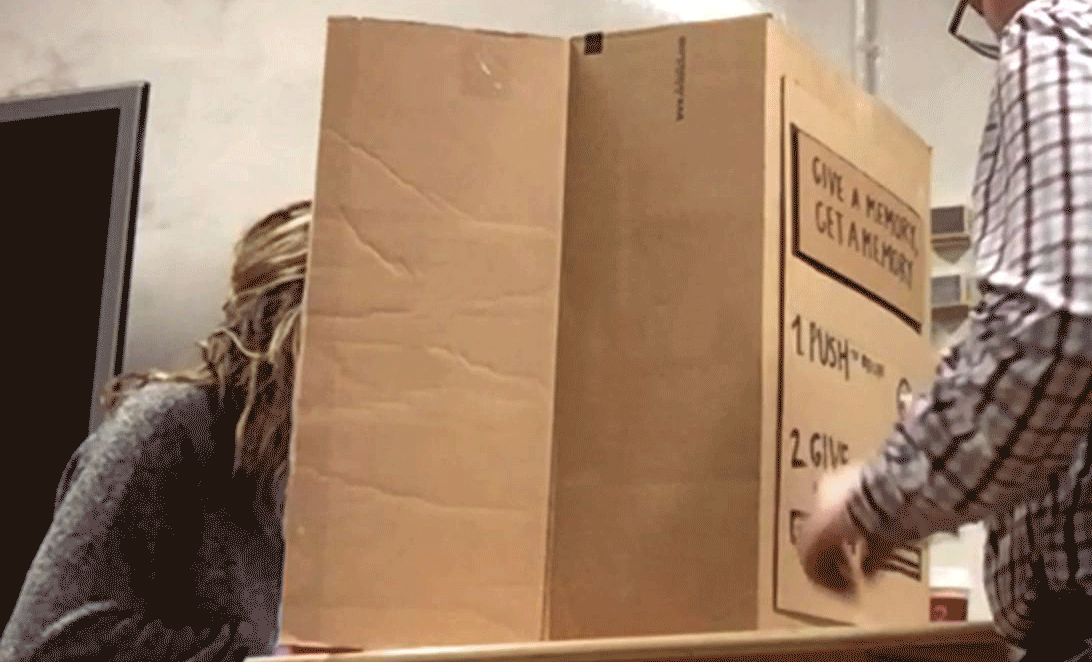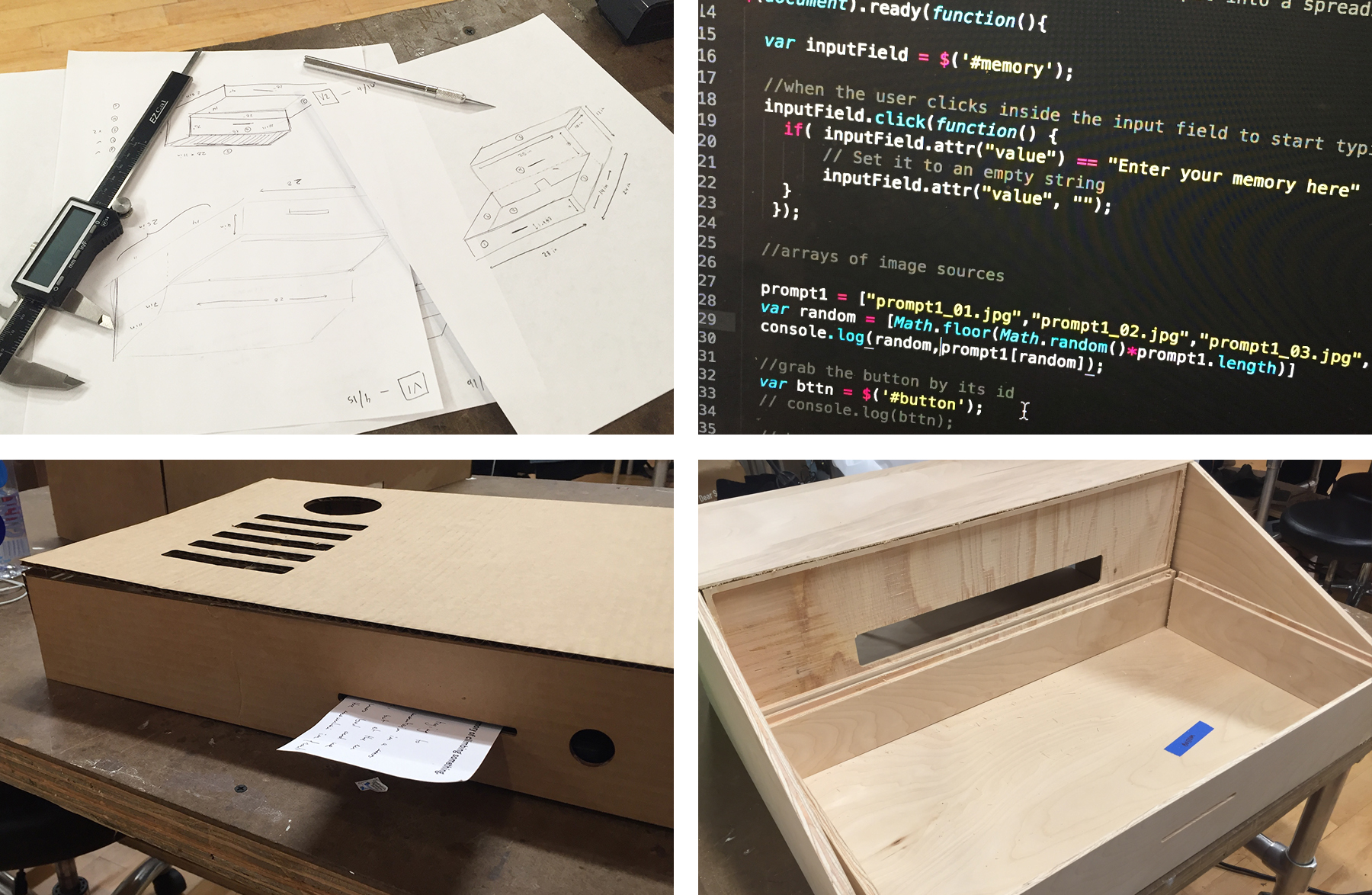
Mnemograph
A participatory installation
Mnemograph
A participatory installation and memory exchange

Mnemograph is a participatory installation that connects two people via the language of their memories.
The installation consists of custom built writing desk, embedded with networked hardware that is largely invisible to the participant. The desk’s interface is simply pen, paper and two slots. Behind the scenes, a tiny scanner, printer, and custom software work invisibly to create an experience that merges digital and analog. Participants are invited to choose a prompt card, and anonymously contribute a handwritten memory. Once they submit their memory through the slot in the desk, they get back a print of someone else’s similar memory. Whether deeply personal, profound or mundane, the other memory provides a brief, and uncanny, moment of connection to another anonymous participant.
Role
Concept, Interaction Design, Art Direction & Visual Design, Software Development & Architecture, Fabrication
YEAR
2016
A participatory installation and memory exchange. Created by Rebecca Lieberman at ITP, Spring 2016.
CONCEPT
How can technology be used to create experiences that encourage human connection through untold stories? And how can interactions mediated by technology facilitate different, more intimate, modes of sharing, and remembering?
Inspired by the idea of personal memory as our untold stories, I began a project of collecting memories from people that ranged from intimate (a heartbreak) to mundane (the smell of a childhood basement).
Struck by the interesting, and often repetitive, language people were using to describe their memories in these early experiments, I decided to create a participatory installation to connect two people through the similar language of their memories. I set out with a basic mechanic for the exchange of memories: A participant submits a memory, and through an automated, behind-the-scenes process, they get back a similar memory from someone else who has participated.

PROCESS: PROTOTYPING – CONTENT
As an experience, Mnemograph is only as strong as people’s contributions. It is a living, breathing installation that changes with the addition of every single new memory, and as a result, eliciting strong and personal content from participants was a priority for me.

During my early prototyping phase, I designed different user tests around collecting memories to see what kinds of content I could source from people using different prompts. I found that people responded to more specific prompts (“Describe a memory of a mirror”) with richer stories than something more generic (“Describe a time you were happy.”) I did a series of prototypes, from paper and cardboard to SMS-based memory exchanges.

In addition to testing prompts, I looked at the language of these memories computationally, using language processing and APIs to pick out key words, analyze sentiment, and break down these memories into their simplest constituent parts.

Process: Prototyping – Interaction
Asking people to reflect and share personal stories demands a lot from them as participants. I was faced with the challenge of designing an interaction to contain both a compelling invitation to participate and a rewarding experience for people.
I tested my interaction both manually and digitally. In one particularly fruitful prototype, I became a memory machine and manually simulated the transaction of giving a memory and getting one back. I learned a lot about the mechanic of my installation, as well as how to provide participants with feedback.

Process: Prototyping – DESIGN
From an interaction design standpoint, I had to create an environment and a physical interface that encouraged reflection and sharing. I aimed to use technology to create a tension, between digital and analog, tangible and ephemeral, anonymous and personal.
I decided to have people handwrite (rather than type) their memories to preserve an analog feeling. I also realized that time and privacy are crucial to cultivating an intimate, contemplative environment for people. I looked at different form factors – from voting booths to prayer shrines – but I decided to use the desk since the act of writing is so central to the project.




Technology
What feels seamless on the outside — writing down a memory, and putting it into what looks like a simple slot — has a fully automated backend written in NodeJS, a Javascript framework. After the participant writes their memory on a card, they feed it through a small document scanner. The scanner saves the image to a server and does optical character recognition to recognize the prompt on the top of the card. Then it automatically sends the memory ‘match’ as an image to a small photo printer embedded in the top of the desk, and the image comes out another slot for the other participant.

FINAL INSTALLATION
Mnemograph has been shown in multiple contexts and has amassed hundreds of individual memories. The memories are diverse – some people contribute really intimate stories; some are funny, some are incredibly mundane. Participants overwhelmingly enjoy the reciprocity of the experience, of sharing and then getting something back from an anonymous memory soulmate.





Awards and Press
Mnemograph was featured in the Communication Arts Magazine 2017 Interactive Annual Issue and given an award of excellence in the Student category. It was also selected as Student Notable work in the Core77 Design Awards within the Interaction category.
In Summer 2016, I showed the project at Flux Factory as part of Artificial Retirement.
Role
Concept, Interaction Design, Art Direction & Visual Design, Software Development & Architecture, Fabrication
YEAR
2016
Tools & Technologies
Javascript (NodeJS)
OCR (Optical Character Recognition)
Document Scanner
Photo Printer